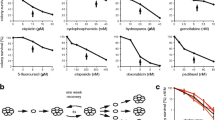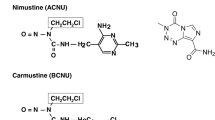Abstract
The objective of this study was to determine the relative importance of the first six complementation groups of the nucleotide excision repair cross-complementing genes (ERCC1–ERCC6) and the first complementation group of the X-ray repair cross-complementing genes (XRCC1), in the repair of DNA damage induced by the in vitro active cyclophosphamide (CP) derivatives 4-hydroperoxycyclophosphamide (4HC) and phosphorodiamidic mustard (PM). We compared the sensitivity of the wild-type CHO cell line, AA8, with that of the CHO mutant cell lines UV4 and UV20 (ERCC1-), UV5 (ERCC2-), UV24 (ERCC3-), UV41 (ERCC4-), UV135 (ERCC5-), UV61 (ERCC6-), and EM9 (XRCC1-). Cell survival was determined using both growth inhibition and conventional clonogenic assays. The yield of DNA crosslinks in selected cell lines was determined using an ethidium bromide fluorescence assay. Results: The rank ordering of sensitivity to both 4HC and PM, based on the combined survival data, was UV41/UV4/UV20≫ UV61/UV24/UV135/EM9≥UV5≈AA8. Thus mutations in the ERCC1 and ERCC4 genes impart a hypersensitivity to CP analogs. To confirm the importance of the ERCC1 gene for cellular resistance to 4HC and PM, UV20 cells were transfected with the human ERCC1 gene and subsequently exposed to 4HC and PM. The transfected cells displayed essentially wild-type resistance to both drugs. Furthermore, two interspecific hybrids derived from UV41, both of which retained the region of human chromosome 16 that harbors the ERCC4 gene, displayed essentially wild-type resistance to 4HC and PM, confirming the importance of ERCC4 for the repair of 4HC-induced DNA damage. When crosslinks were assayed after a 60-min treatment with 4HC or a 15-min treatment with PM, their yield paralleled the sensitivity of the cell lines to both drugs: UV41 cells showed markedly elevated levels of crosslinks, whereas AA8 and UV5 cells showed similar (low) levels of crosslinks. Conclusions: Our findings confirm the general pattern indicating that the ERCC1 and ERCC4 gene products are crucial for the repair of 4HC-induced DNA damage, while the other nucleotide excision repair genes examined are relatively unimportant. These data suggest that the hypersensitivity of ERCC1- and ERCC4- mutants to DNA crosslinking agents may reflect a defect in recombinational repair rather than nucleotide excision repair.
Similar content being viewed by others
Author information
Authors and Affiliations
Additional information
Received: 1 August 1995/Accepted: 18 December 1995
Rights and permissions
About this article
Cite this article
Andersson, B., Sadeghi, T., Siciliano, M. et al. Nucleotide excision repair genes as determinants of cellular sensitivity to cyclophosphamide analogs. Cancer Chemother Pharmacol 38, 406–416 (1996). https://doi.org/10.1007/s002800050504
Issue Date:
DOI: https://doi.org/10.1007/s002800050504




